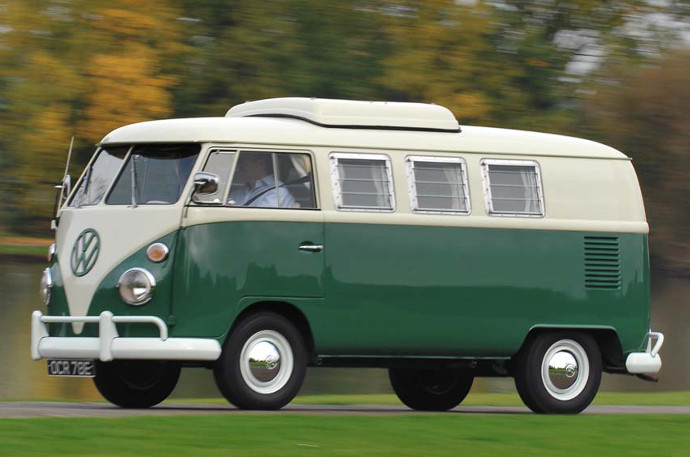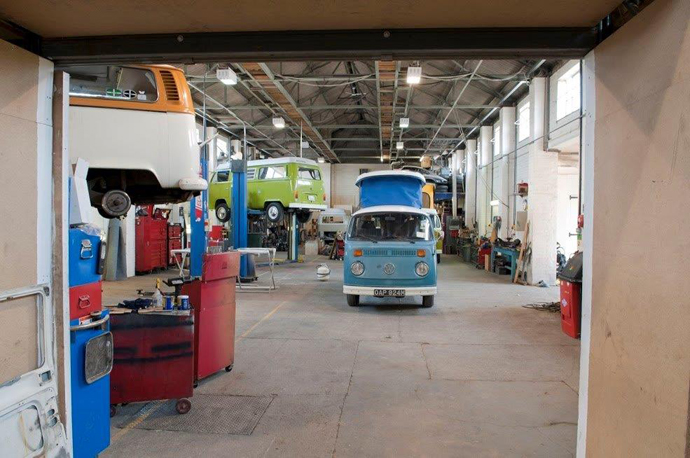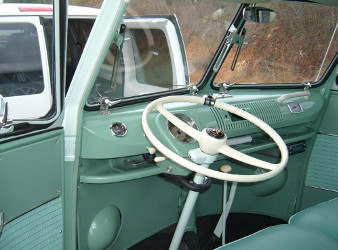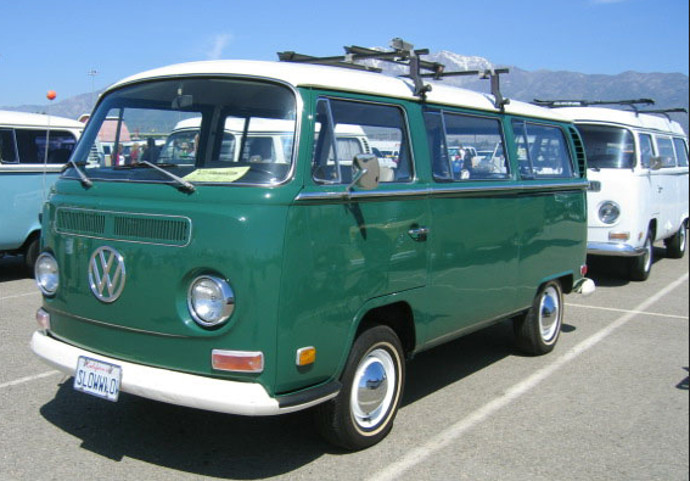We don’t need to tell you just how cool old VW buses are right now, be it a split or bay window model. Even the shortest trips will feel fun, and everywhere you go you will be greeted by smiling faces and looks of admiration.
There’s no doubt it’s the must-have mode of transport of the moment, the ultimate in chic family transportation – and if you don’t believe us, just check out the growing number of celebrity owners! So here’s our warts n’ all guide to buying the best VW bus. So hang on tight and prepare yourself to become a member of the world’s hippest cult that’s ever existed…
Driving
Okay, an early split won’t be ideal for long motorway jaunts, but if you don’t mind pottering there’s no reason why you shouldn’t enjoy it to its maximum. Bay windows with bigger engines are better for everyday use, but even then you need to be realistic when it comes to driver expectations. You’ll hopefully love being behind that huge, thin rimmed wheel but don’t expect it to do everything a modern car will do. It will be slow, thirsty and will probably break down a few times – but hell, that’s all part of the VW bus ownership experience so if you can’t handle it, buy a T25 or T4 instead.

As for memorable dates, here’s all you need to know: the split made way for the single screen Bay in 1967, in around 1972 the arches were flared and later on the front indicators moved from just above the bumper up to the front panel and the rear oval lenses were replaced by bigger, rectangular units. The crossover models were those with big rear lenses, higher indicators and the small bumpers. In 1973, there was a major visual revamp when the delicate wrap around earlier bumpers were replaced by chunky square items and the higher positioned front indicators and bigger rear lenses became universal. At the same time, the Type 4’s ‘suitcase’ 1.7-litre became available and this was replaced by the 1.8 in 1974. By 1975 customers could specify the longer stroke 2.0-litre, although the 1.6 was still available. The air cooled bus stopped altogether in 1979. For reference with Bays, the third digit of the chassis number denotes the build year, so 218 000 001, for example is a ’68, 219 000 001 a ’69 and so on.

Bodywork
Starting with undoubtedly the most important bit first, you need to put body condition and lack of serious corrosion way above anything to do with the mechanicals. To be brutally honest, whether you are looking at a split screen model or a Bay, they all rust horribly. The hope is that you find one that’s either pretty original and rot free, or an example that has been extensively and properly restored. Bear in mind, a couple of decades ago interest in buses wasn’t as great as it is now, so lots were bodged – and these are best avoided unless you want to spend a fortune putting right somebody else’s short cuts. If you spot a camper without the seams in the side of the arches, for example, you know it’s been butchered.

Rust can take hold just about everywhere, but worst hit areas are the lower front panels behind the bumper, the outer sills, the bottom corners, tailgates, front door bottoms and areas around the window rubbers. Often a van that looks vaguely okay bodywise can be rotten underneath, so it’s also important to closely eyeball the inner sills, chassis rails, out-riggers, jacking points and floorpan.
Everything is available in terms of repair panels for the split here and the Bay here, but you need to ask yourself how far are you willing to go? If you’re looking at a bus that’s selling for big bucks, ask to see photos of any restoration work – they should have them on file. Failing that, get an expert restoration company to come and have a look with you to avoid the risk of buying a rust bucket.
Engines
Air cooled engines can go on forever if properly looked after but the stress put on them by the extra weight of a van, especially if it’s a fully kitted out camper, can eventually take its toll. As always, oil is the lifeblood of the engine, so you need to see proof that it’s had fresh minerals and its filter cleaned every 3000 miles. Oil leaks are common, but if it’s from the back of the engine it’s not good news because it’s probably the flywheel oil seal which is tricky to replace.

Blue smoke indicates worn valve guides, while general lack of beans means bore wear and rubbish compressions. Grab the lower pulley and give it a yank; excessive movement points to end float in the main bearing which means you’ll need a rebuild.
On the whole, though, anything like this can be used as a bargaining tool as long as the bodywork’s promising because top quality exchange engines are aplenty and carrying out a swap at a later date won’t be an issue.
For reference engine codes B, AD and AS are 1600s, CA, CB, CD are 1700s, the 1800cc has the engine code AP, while the 2000cc unit will carry the code CJ, GD or GE.
Running gear
To be honest, there’s very little to worry about regarding brakes, suspension and electrics because replacement VW Type 2 parts are inexpensive and readily available. View split bus stuff here, and all the Bay window bit’s you’ll need here. Later buses have discs at the front which offer more assurance, although the drums on older examples are good if properly set up. Here, make sure the vehicle pulls up in a straight line on a test drive.

Lots of buses are lowered and this can dramatically improve handling if done sympathetically. The most common method is to weld adjusters into the front beam so you can easily raise them back up again. If this has been done, check the quality of the work. At the rear it’s simply a case of turning the beam on their spring plates to get the desired drop. If you’re after a family wagon as opposed to a show queen, it’s best to stay clear of anything that’s been radically altered as it will be horrible to drive.
Interior
There have been various companies offering camper conversions over the years, including Danbury, Dormobile, Canterbury, Devon and Westfalia to name just a few. There’s also the option of having a fixed, high top or elevating roof. On the whole there’s little to choose between the different conversions, although it’s worth viewing as many different vans as you can to see which internal layout works best for you. If you’re a purist, original condition will be important. Otherwise, as long as items such as the sink and cooker are working, the rest of the interior – including the cabinets and upholstery – can be easily refurbished.


Watch out for home conversions; items such as fridges need to have proper external ventilation, so make sure this is in place.
What to pay?
As you’re no doubt aware, all bus prices have gone through the roof in the last few years which is good news for owners, and rubbish for anyone interested in buying. Realistically, you are unlikely to find a split screen bus in any shape or form for anything less than £10,000 with the cheapest kombis (with the potential of conversion into a camper) likely to be £15,000. Half decent bona fide split campers that are ready to roll will be anything from £20,000 right up to £60,000-£70,000. Bays are going the same way, although you might get lucky and stumble across a ratty project for £5000, with usable ones changing hands for between £10.000-£15,000. The nicest examples, however, can still easily make in excess of £20,000.

Verdict
It’s now or probably never where the VW bus is concerned. The bubble hasn’t burst yet, although traditionally the end of the summer is when people sell their vehicles so you might get a bit of a bargain. If a split’s just too much now, go for a Bay – and if you want one that’s bodily solid, buying an import from the US or Australia might be the best way to go – the latter, of course, having the benefit of right-hand drive. The key will be to swot up on where they rust and go into the buying process with your eyes wide open.. If you do buy a rusty project, rest assured if you are able to do the work yourself you’ll be sitting on a great investment. If you propose paying someone else, bargain accordingly and bear in mind there’s always going to be more rust than you first envisaged!
Otherwise, buy, fettle, drive – and enjoy.
Ian
The opinions expressed here are the personal opinions of the author and do not necessarily represent the views and opinions of VW Heritage.


I had contemplated buying a VW-Bus and your tips were very useful. As an industry-insider and having worked in the automobile industry for more than two decades I feel your suggestions come in handy to first time buyers and those looking to make an investment in these buses.
That is awesome, just curious how much did you spend for that kind of repair?
What’s the deal with brazilian imports? They are worth less right? Are they considered original even pls?
Great.whats the cost of a refurbished T1 kombi engine